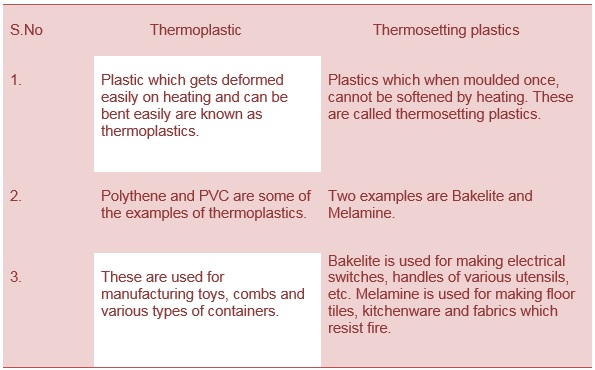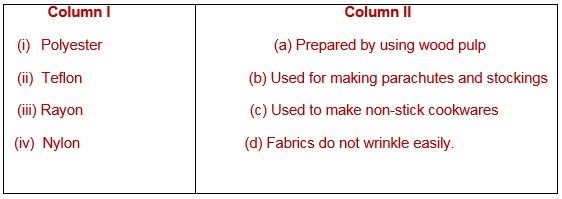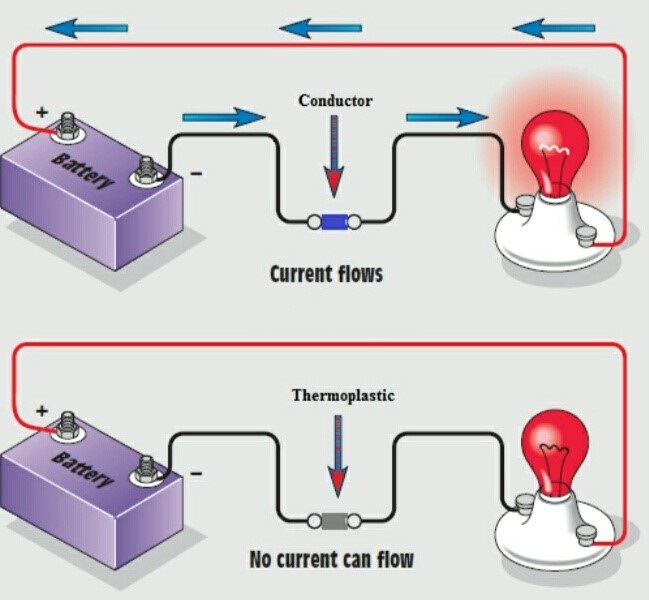Science
(www.olympiadsuccess.com)
Chapter 3: Synthetic Fibres and Plastics
Class: VIII
NCERT Solutions
Question 1. Explain why some fibres are called synthetic.
Answer 1. Some fibres which are not natural (man-made fibres) called synthetic because they are made by chemical processing of petrochemicals. The synthetic fibres are made up of very large units called polymers. Some of the synthetic fibres are rayon, nylon and acrylon.
Question 2. Mark ( √) the correct answer:
Rayon is different from synthetic fibres because
(a) it has a silk like appearance
(b) it is obtained from wood pulp
(c) its fibres can also be woven like those of natural fibres
Answer 2. (b) it is obtained from wood pulp
Question 3. Fill in the blanks with appropriate words:
(a) Synthetic fibres are also called ______ or _______ fibres.
(b) Synthetic fibres are synthesised from raw material called ________.
(c) Like synthetic fibres, plastic is also a __________ .
Answer 3.
(a) Synthetic fibres are also called man-made or artificial fibres.
(b) Synthetic fibres are synthesised from raw material called petrochemicals.
(c) Like synthetic fibres, plastic is also a polymer.
Question 4. Give examples which indicate that nylon fibres are very strong.
Answer 4. Nylon is a very strong fibre that is why nylon is used for making parachutes, rock climbing ropes, fishing nets seat belts etc. A nylon thread is elastic and light but actually stronger than a steel wire.
Question 5. Explain why plastic containers are favoured for storing food.
Answer 5. Plastic containers are favoured for storing food for the following reasons:
Question 6. Explain the difference between the thermoplastic and thermosetting plastics.
Answer 6. Difference between the thermoplastic and thermosetting plastics:

Question 7. Explain why the following are made of thermosetting plastics.
(b) Electric plugs/switches/plug boards
Answer 7.
(a) Melamine (a thermosetting plastics) resists fire and can tolerate heat better than other plastics. So, it is used for making Saucepan handles, which resist fire.
(b) Bakelite (a thermosetting plastics) is a poor conductor of heat and electricity. So, it is used for making Electric plugs, switches, plug boards, etc.
Question 8. Categorise the materials of the following products into ‘can be recycled’ and ‘cannot be recycled’:
Telephone instruments, plastic toys, cooker handles, carry bags, ball point pens, plastic bowls, plastic covering on electrical wires, plastic chairs, electrical switches.
Answer 8. Plastic toys, carry bags, ball point pens, plastic bowls, plastic covering on electrical wires and plastic chairs can be recycled as these are the thermoplastic. Telephone instruments, cooker handles and electrical switches cannot be recycled as these are thermosetting plastics.
Question 9. Rana wants to buy shirts for summer. Should he buy cotton shirts or shirts made from synthetic material? Advise Rana, giving your reason.
Answer 9. Rana is advised to buy a cotton shirt for summers because cotton absorbs the sweat and the pores in cotton allows easy evaporation and keeps our body cool, whereas synthetic shirts don’t absorb sweat so, they are very uncomfortable to wear in summers.
Question 10. Give examples to show that plastics are noncorrosive in nature.
Answer 10. We can store various kinds of chemicals and other materials in plastic containers because they are non-reactive and does not react with water and air. Ø Teflon, a kind of plastic is used as a coating to manufacture non-stick cookware. Ø Bakelite is a poor conductor of heat and electricity so it is used for making electric switches and handles of the utensils. Ø Melamine is used for making floor tiles and kitchenware.
Question 11. Should the handle and bristles of a tooth brush be made of the same material? Explain your answer.
Answer 11. The bristles of a tooth brush should be made of soft material so that it does not harm the gums and the handle should be made of hard material so that it can give a firm grip. Therefore, the bristles are made up of nylon fibres which are strong, elastic, lustrous, light weight and easy to handle and the handle is made of hard plastic as it is strong, durable, poor conductor of heat and electricity.
Question 12. ‘Avoid plastics as far as possible’. Comment on this advice.
Answer 12. Now a days, plastics become very important in our daily life, even though we should avoid them as far as possible as for the following reasons: Ø Plastics are non-biodegradable and take a lot of time to decompose. Ø Plastics are not eco-friendly. By burning plastics, poisonous fumes are released that cause air pollution. Ø Sometimes cows and other animals may eat plastics present in the garbage which may choke their respiratory system and even cause death. Ø The plastic left in the soil results in soil pollution. Ø Plastic bags drained into the water bodies cause threat to the aquatic life also. Ø Polybags choke the drains and sewage pipes thus causing lot of trouble
Question 13. Match the terms of column I correctly with the phrases given in column II.

Answer 13. Match the terms of column I correctly with the phrases given in column II.
|
Column I (i) Polyester (ii) Teflon (iii) Rayon (iv) Nylon |
Column II (d) Fabrics do not wrinkle easily (c) Used to make non-stick cookwares (a) Prepared by using wood pulp (b) Used for making parachutes and stockings |
Question 14. ‘Manufacturing synthetic fibres is actually helping conservation of forests’. Comment.
Answer 14. Synthetic fibres are man-made fibres. These fibres are made from petrochemicals. For manufacturing synthetic fibres cutting of trees or killing of animals is not required and we can conserve our natural environment using synthetic fibres. Hence, 'manufacturing synthetic fibres is actually helping conservation of forests’
Question 15. Describe an activity to show that thermoplastic is a poor conductor of electricity.
Answer 15. Take a small piece of thermoplastic material and connect it between the circuit as shown in the figure. When we connect conductor in the circuit, current passes through it and the bulb glows but if we connect thermoplastic in the circuit, no current passes and the bulb does not glow.

Yearlong program for Olympiads preparation & to build necessary skills for future.
Explore More
Time to mark your calendar with the upcoming Olympiads exam schedule.
Explore More
Take your Olympiad preparation to next-level by taking LIVE Classes.
Explore More
Assess your performance by taking topic-wise and full length mock tests.
Explore More
Online tuitions for international compeitions like SASMO, SEAMO, etc for Grades 1-11.
Explore More